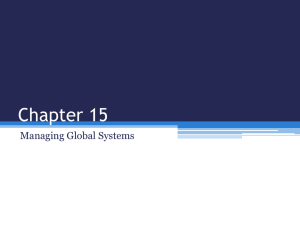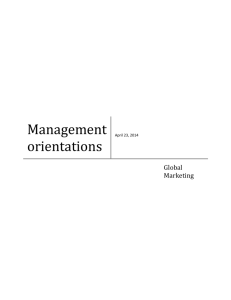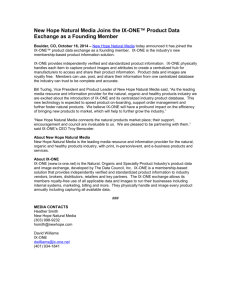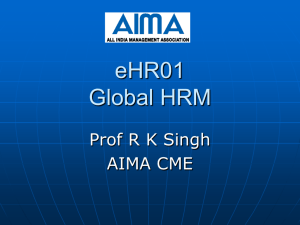Innovation Management
advertisement
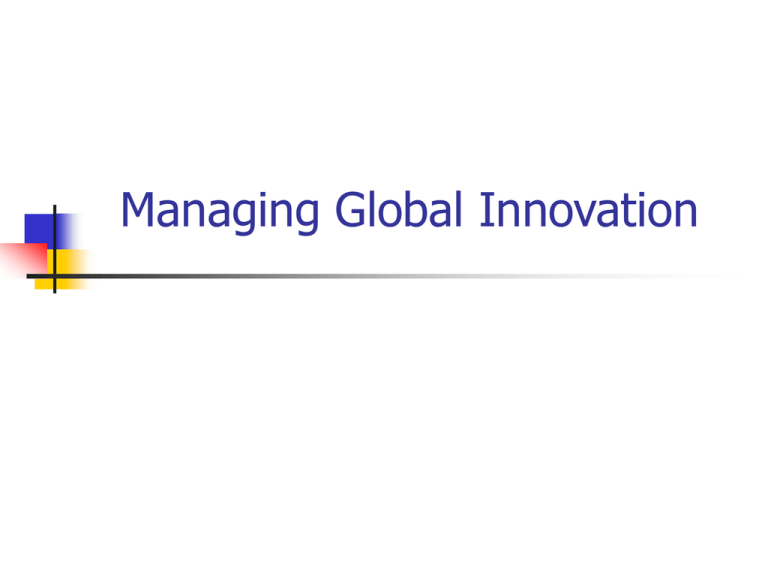
Managing Global Innovation Afuah (2003) Market information needs Strategies for Worldwide Innovation Multidomestic Transnational Unilever Caterpillar International Global P&G Intel High Low Low High Technological information needs Strategies for Worldwide Innovation Emphasis Description Local responsiveness Allows foreign subsidiaries to operate nearly Multinational autonomously; the firm can quickly sense and (multidomestic) and differentiation respond to local needs Global Global efficiency Global activities are closely managed through central control from the headquarter. The firm capitalizes on economies from standard product design, global-scale manufacturing, and centralized control of worldwide operations. International Rapid deployment worldwide Foreign subsidiaries operate autonomously but are critically dependent on the headquarter for new processes, new products, and know-how. Transnational Global efficiency, Integrate global activities through close local responsiveness, interdependence and mutual cooperation between high innovativeness headquarter and foreign subsidiaries. Factors Driving R&D Internationalization Boutellier et al. (2000) Factors Affecting R&D Internationalization Five Organizational Concepts of international R&D Organization Dispersion of internal competencies & knowledge bases Low c) Polycentric Decentralized R&D e) Integrated R&D Network d) R&D Hub Model a) Ethnocentric Centralized R&D Competition b) Geocentric Centralized R&D Degree of cooperation between R&D sites Cooperation Different International R&D Organizations Configuration Organizational structure Behavioral orientation a. Ethnocentric centralized R&D Centralized R&D National inward orientation b. Geocentric centralized R&D Centralized R&D International external orientation c. Polycentric decentralized R&D Highly dispersed R&D, weak center Competition among independent R&D units d. R&D hub model Dispersed R&D, strong center Supportive role of foreign R&D units e. Integrated R&D network Highly dispersed R&D, several competence centers Synergetic integration of international R&D units Different International R&D Organizations Configuration Ethnocentric centralized R&D Pros • • • • Geocentric centralized R&D • • • Polycentric decentralized R&D • • • Protected core technologies High efficiency Low R&D cost (scale & specialization effects) Short cycle times High sensitivity for local market & technological trends Efficiency due to centralization Cost - efficient R&D internationalization Strong sensitivity for local markets Adaptation to local environment Usage of local resources Cons • • • • • • • • • Low sensitivity for local markets Danger of missing external technology Not-Invented-Here syndromes Tendency toward rigid organization Danger to neglect systematic internationalization Local content restrictions & local market specifications insufficiently considered Inefficiency & parallel development No technological focus Problems with critical mass Different International R&D Organizations Configuration R&D hub model Pros • • • • Integrated R&D network • • • • High efficiency due to coordination of R&D Avoidance of redundant R&D Exploitation of all available strengths Realization of synergies (quick recognition of local demand & the sustaining integration of global R&D input) Coupling of specialization & synergy effects Global before local efficiency Organizational learning across many locations Exploitation & refining of local strengths Cons • • • • High costs of coordination and time Danger of oppressing creativity & flexibility through central directives High coordination costs Complexity of institutional rules and decision processes Trends in Organizing International R&D High Dispersion of internal competencies & knowledge bases Low c) Polycentric Decentralized R&D e) Integrated R&D Network 4 3 d) R&D Hub Model 2 a) Ethnocentric Centralized R&D Competition 2 1 b) Geocentric Centralized R&D Degree of cooperation between R&D sites Cooperation THE END
